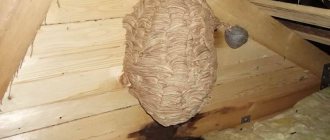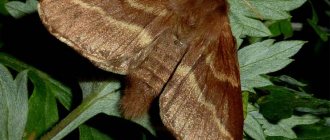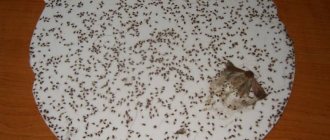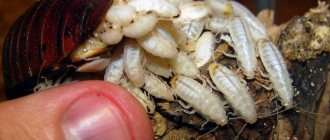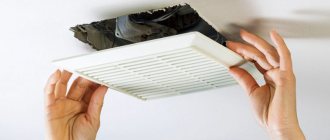In the spring, unwanted neighbors often appear on a summer cottage or in a private house - wasps, bees and hornets, which are dangerous to humans, wooden buildings and garden trees. To avoid stings and damage to structures, it is important to know how to get rid of hornets and prevent them in the future. Traditional methods, pesticides and mechanical destruction of nests can help solve the problem.
Hornets are large insects that cause fear with their appearance, and their bites are dangerous to life and health. In order to protect yourself and your site, it is important to know how to deal with pests and destroy their nests
The article contains effective methods for exterminating pests, and also presents effective preventive measures that will help prevent the occurrence of such a problem.
What is the danger of hornets
The hornet (a genus of social wasps), due to its striped black and yellow color and pronounced “waist”, is often confused with a wasp, although it is larger in size - from 3 to 5.5 cm. Upon careful examination, you will notice that it is also distinguished by its ingrown chest, head and chocolate-colored belly. Representatives of eight species live in Russia, each of which has its own characteristics.
An adult needs nectar, sweet berry and fruit pulp, and sugar-rich plants for nutrition, so berry plantings and fruit trees suffer. They also hunt for insects and arachnids, without distinguishing between beneficial and pest - the larvae need protein food. It is delivered chewed (suspension). Hornets cause great harm to gardens and vegetable gardens, destroying bees, beneficial bugs, spiders, and damaging fruits.
The insect is aggressive and attacks if disturbed. Bites are unsafe for humans and animals, and there are reasons for this:
- the toxins in the venom are similar to those of a rattlesnake;
- the bite is painful, the inflammatory process develops at lightning speed;
- can attack several times and inflict more than one bite, because the sting, unlike a bee, does not leave in the victim’s body;
- when attacking, it releases special substances - pheromones, which attract relatives to help;
- reactions to a bite depend on the characteristics of the body - from slight swelling and inflammation, mild painful manifestations to serious allergic reactions, heart rhythm disturbances, asthmatic manifestations, nervous breakdown, and sometimes anaphylactic shock.
Like all social insects, hornets quickly mobilize when they receive a danger signal (a special pheromone) and rush to the rescue of their relatives. If this happens near the nest, the whole family will fly in. This is especially dangerous for young children - during a massive attack, internal organs suffer, and sometimes problems with the immune system arise.
Where are colonies established?
Social wasps need carbohydrates for normal life, so they often establish their colonies in gardens, orchards, or nearby. They can be seen near the remains of rotting fruit on compost heaps, on trees dripping with sweet juice.
For the nest, choose quiet places protected from rain and wind under a canopy, roof, attic, in hollows, old stumps, earthen holes, barns, woodpiles. For construction, chewed wood is used, mixed with saliva, which acts as glue. Externally, the structure is at first similar to a pear or a ball, then it is completed and the shape changes. The walls resemble corrugated paper, the color depends on the type of wood.
Hornets live in a nest for only one season and do not reuse it. The fertilized queen finds another place to build in the spring.
How to find a nest
If an insect begins to appear frequently on the property or in the yard, it means there is a nest somewhere nearby. You need to make a walk around the territory, inspect buildings, attics, secluded places, old trees, stumps. You can listen - the swarm makes a lot of noise, follow the flight and go to the habitat. The sooner this is done, the better - at an early stage of development, it is easier to destroy a family.
If you can't track it down, you can try the following steps:
- try to stun a flying insect with a towel, newspaper, racket, while watching to see if any relatives appear;
- tie the body with a thin colored thread (protect your hands with gloves);
- wait until the insect comes to its senses and flies further;
- The thread will allow you to find the habitat.
Having settled near an apiary, hornets are capable of causing significant damage, destroying bees. Bees will not give up so easily, but they do not always have the opportunity to cope with a large individual.
Where can they build nests?
Hornets build their nests from chewed wood mixed with saliva, with the saliva acting as glue. The structure of the nest shell is similar to corrugated paper, the color of which depends on the type of wood from which it is made.
Hornets only live in their nest for one season and never reuse it. 6 effective ways to destroy a hornet nest.
In the spring, having overwintered in a secluded corner protected from the cold and wind, the young fertilized hornet queen finds a suitable place to build a new nest. They can be quiet, secluded places, protected from bad weather: a garage, attic, barn, abandoned building, hollow tree. There the queen attaches a small leg on which she builds the first comb cells. In them she lays eggs, from which larvae subsequently develop, and then working hornets appear, which begin to further expand the nest.
Interesting to know! Some species of hornets settle in abandoned burrows.
Methods of dealing with hornets
The best time to fight is when nest construction begins. Construction begins in the spring, when the air warms up to +10 °C. There are few insects during this period, so it is easier to deal with them. You can use chemicals and folk remedies, the action of which is aimed at destroying an individual, an entire family, along with its home. Any procedure is carried out in compliance with safety measures.
Fire extinguisher treatment
The foam from the fire extinguisher blocks the access of oxygen, closes the hole, so insects cannot get out. The treatment is carried out in the evening or at night, directing the stream to the nest itself, to the space nearby. After the foam hardens and the insects die, the nest is removed, taken out of the area, and then destroyed. You can replace the fire extinguisher with a can of polyurethane foam.
Using a smoke bomb
The use of a smoke bomb (for example, Mukhoyar, FAS, HELP) is permitted in residential and other premises, in open space. Pets, plants, aquariums should be isolated, children's access should be controlled, and ventilation should be provided. As users note, the effectiveness of the checker is high, it is convenient to use, since it is possible to be at a distance.
Treatment should not be carried out on people prone to allergies or with respiratory diseases.
Kerosene with water
You will need a large container filled with water mixed with kerosene (vinegar, bleach). The nest is knocked down directly into the container, and using improvised means, it is sunk, holding it under water. The walls quickly become wet, the inside fills with water, and the inhabitants die.
Plastic bag
In the dark, the activity of hornets decreases, which is used to eliminate the insect using a regular plastic bag. A large bag or bag is treated with an insecticidal preparation, brought to the nest, which is removed in any convenient way (cut, knocked down) directly into the bag. The hole is tied up after once again spraying the poison inside. The package is burned or taken off site.
Repellers
In some cases, hornets, like wasps, are enough to scare off and they may not return to their “home” place. The method is based on an instinctive fear of fire - insects, sensing the smell of smoke, leave the home. To scare away, the nesting site is fumigated with smoke, repeating the procedure 2-3 times with an interval of several days. Whether the residents will return is unknown, but it’s worth a try.
How to destroy a nest
In an open space far from buildings, a hornet nest can be destroyed by fire - douse it with gasoline, kerosene and set it on fire. Combustible materials and dry grass nearby are removed and care is taken to ensure that the fire does not spread to bushes or trees. The method is unsafe, but effective.
How to remove hornets using folk remedies
In the spring, when the population has not yet grown, you can use folk remedies that are safe for humans and animals to get rid of hornets.
Proven methods:
- Place a piece of raw meat near the habitat - insects that flock to the smell are sprayed with an insecticide (the procedure is carried out several times);
- crushed fly agaric caps (3 pieces) + honey (100 g) + water (200 ml) - boil, put in jars (0.5 l), place in places of accumulation;
- boric acid (3 tbsp) + boiled water (50 ml) - boil for 10-15 minutes, pour into small containers, place near the nest (foraging hornets will be affected, but not the entire family);
- plant herbs with a specific aroma (for example, geranium, lemon balm, mint) around the perimeter of the site, near the house;
- wait until winter, remove the nest with its sleeping inhabitants, drown it in a container of water or, wrap it in plastic, take it outside the site.
Fresh pods of aromatic hot pepper are used as a deterrent; they emit a specific smell, which is what wasps and hornets are afraid of. They will not fly into the hive or, conversely, will not fly out, which will cause death.
Bees under the roof
Bees under the roof
If a bee family has settled under the roof of a house, you can drive away and remove the bees in one of the following ways:
Early in the morning, before the bees have gone about their business, in full equipment (beekeeper's suit, gloves), carefully lower the nest hanging under the roof into a bucket of water. The insects' wings will become wet and they will not be able to fly away. As a result of the described actions, the entire family will completely die
Despite the fact that the method is quite effective, it is very dangerous, so the closest attention should be paid to your own safety measures. A similar folk method for getting rid of a beehive under a roof involves using a plastic bag. The difference with the previous method is that this technology is somewhat more humane
The bees placed in the bag remain alive. If they are not killed (by drowning or burning), then, if desired, the insects can be released into the wild away from the site. If the nest is located directly under the roofing or in another hard-to-reach place, you can try a product such as polyurethane foam. In this case, the most important thing is to make sure that all entrances and exits to the hive are completely filled with foam. After the composition hardens, the bees will die from lack of air. If it is not so much the roof that has suffered from the infestation of bees, but the attic, the question of how to get bees out of the house may have a very simple answer - using an ordinary household vacuum cleaner.
It is also recommended to carry out the procedure in the morning in order to catch the whole family in place. This is done as follows: the pipe of the household appliance is directed into the nest, the bag with the bees is carefully removed. Each homeowner has the right to decide individually what to do with the bees next (kill them or release them into the wild).
Lures and traps
Insects that were absent at the time of the procedure and managed to fly away return to the site of the destroyed housing. Homemade traps with bait will help you deal with single individuals. As bait, they take foods whose smell and taste are liked by all wasps: pieces of spoiled fish, a mixture of honey and beer, sour jam or syrup.
To prevent sweet-loving bees from falling into the trap, the bait must be made from fermented products - the bees are not greedy for them. Hornets like the presence of alcohol, so mash or beer is suitable.
Trap options:
- Duct tape. Sweet syrup and honey are applied to thin strips of cardboard or thick fabric and hung where flying predators gather. Having stuck to the strip, they cannot fly away and die. The strips are periodically replaced with new ones;
- Can + bait. A cut is made in the lid in the form of a cross, the edges of the cut are folded inward, and the jar with the bait is closed. They are placed where hornets often appear, near places of accumulation.
- Plastic bottle + bait. The upper part (approximately 1/3 of the height) of the bottle is cut off, the bait is placed on the bottom, the cut off part (without the cork) is inserted upside down, and placed in visible places.
- Plastic bottle (2-5 l) with a tap hole + bait. A midge bait is placed at the bottom, the neck is closed with a lid, cuts are made on the sides of the bottle, tap holes (2-3) cut from bottles of a smaller volume are inserted (the top part is cut off). Once inside, the wasp will not be able to get out. Instead of tapholes, you can drill holes with a diameter of 8 mm.
- Water + sweet syrup. Water mixed with fermented syrup and jam is poured into a wide container (bucket, pan) and placed near habitats.
You should not hope that traps will help get rid of large colonies. They are effective against single or small numbers of individuals and remnants of a settlement. They are also convenient to use when random “visitors” often fly into the site.
Why get rid of
For those who understand even a little about entomology, it is no secret that hornets are predatory insects that feed on meat. And although many sources try to portray them as some kind of “killers” who deliberately get rid of the bees’ neighborhood, everything does not happen quite like that. The fact is that hornets, in order to constantly grow and function normally, as well as ensure the viability of their colony, need to find new prey.
They are forced to kill other insects and transfer them to their nest for the sake of their own survival and procreation. True, this fact will be of little comfort to the beekeeper, next to whose hives a colony of these dangerous insects has formed. After all, the hornet will always consider the bee house as an ideal food object. For him, this is a fairly large accumulation of insects suitable for food, which are very easy for him to catch. And if he destroys the nest, then he can also enjoy the honey. And don’t think that this formidable insect, which prefers to get meat, will miss such a sweet delicacy for itself.
It is important to understand that adults eat sweet products (honey, fruits, flowers, etc.), while meat is needed for the younger generation.
When the beekeeper understands all these facts, he clearly realizes that he needs to do everything to destroy the hornets on his territory or in the immediate vicinity of the apiary.
Therefore, further we will consider in detail all the steps that a beekeeper needs to perform in order to prevent such a nuisance.
How can you poison hornets?
To destroy inaccessible settlements, there are powder and aerosol chemicals. They are used strictly according to the instructions, taking precautions: a respirator, gloves, a tight suit that protects against bites. It is better to carry out the procedure in the evening or at night, when insects are less active. There is no need to turn on the flashlight, otherwise the light will cause it to fly out. The nest is destroyed as soon as the inhabitants die.
An article on the topic of midges in the apartment. Why do they appear, how can you get rid of them and what means to use.
How to use:
- Spray the product directly onto the nest for a few seconds, repeat treatments if necessary;
- prepare the composition for weeding, pour it into a bag, put it on the nest, tightly, secure with tape or twine;
- if a family has settled in a hollow or hole, then pour the solution there and close the hole tightly with rags, clay, foam, etc.
List of drugs:
| Name | How to use | Distinctive features |
| Argus Garden | Trap for single individuals | Safe for humans and animals; several pieces can be installed over a large area |
| Bros (BROS) | Aerosol, spray on the site of accumulation | Burn dead insects to prevent poisoning of pets |
| Karbofos | Powdered product, prepare a solution (10 g + 1 l of water) | Spray areas of accumulation from a distance of 3-4 m, first paralysis occurs, then death |
| Delta Zone | Prepare a solution for spraying (according to instructions) | Safe for humans and animals, odorless, acts gradually, destroys adult insects and larvae, validity period - 8 weeks |
| Dichlorvos | Aerosol, spray in areas of accumulation | Effective within seconds of contact, protective barrier lasts two weeks |
| Dr. Klaus | Time of exposure to the jet - 10-20 seconds | Has no smell. The treatment should be carried out without access to fresh air and can be repeated several times. Suitable for residential and non-residential premises. Convenient for use in hard-to-reach places, narrow crevices (there is a special nozzle) |
| Medilis-super | The concentrated product (ampoules, bottles) is diluted according to the instructions and poured into a spray bottle | Has a strong odor, one treatment is effective for 1-1.5 months, suitable for open space, indoors |
| Mosquitol | Aerosol, spray in crowded areas, maximum distance - 6 m | Designed for treating non-residential premises, outdoors |
| Otos | Prepare a solution (10 g + 100 ml of water), spray the hole, nest, hollow | The action doesn't start right away, so you need to be prepared for a swarm attack |
| Wespex Quick | Spray spray | Effective against wasps, bees, hornets, safe for humans and animals |
The effect of any product is greater if the treatment is carried out without air access. For example, indoors, when isolating the nest with a bag or cellophane.
Ways to get rid of insects
Sometimes people and hornets can get along well, but in some situations the insects build their nests in undesirable places, posing a threat to others.
In such cases, you have to get rid of them; this can be done in different ways:
- Setting traps often cannot completely get rid of unwanted neighbors, but it allows you to destroy individual individuals that get too close to a person or territory where they should not be.
- The use of various chemicals, most often aerosols containing insecticides. This technique is one of the most effective, and it allows you to get rid of insects instantly. However, the use of insecticides also has a certain risk, since it may not be possible to destroy the hornets the first time, and such an attack will anger the inhabitants of the nest and provoke them to launch a counterattack.
- Call professionals from specialized services that deal with the destruction of all types of insects. This method is the most recommended, since it allows you to get not only a guaranteed result, but also protection from the reappearance of unwanted neighbors for a certain period of time. The only drawback of this option is the very high cost compared to other methods.
There are other ways to combat hornets, but the options discussed are the most popular, since other analogues are more dangerous. Regardless of the chosen method, they all boil down to one thing - the need to destroy the nest.
How to call pest control services
If you don’t know how to destroy hornets or remove the nest, you should contact specialized services. They have a number of advantages over non-professional methods: the treatment is carried out with special equipment and potent drugs that meet the requirements of Rospotrebnadzor. The qualifications of the specialist are also important.
Most often, a generator is used that supplies a solution of a toxic substance under pressure. The mixture easily penetrates into inaccessible and remote places, so a single treatment is sufficient. There is no danger to others, since specialists take into account all the nuances.
What to do:
- find out information about the company, whether there is a certificate, compare prices, read reviews;
- conclude an agreement where the nuances, price, and guarantees must be specified.
Specialists are called to exterminate hornets on the territory, in any premises. Addresses of local services can be found on the Internet.
Calling specialists
This method of exterminating hornets is the safest, since the employees of the selected organization will do all the work themselves.
This option has several features that need to be taken into account:
- Today there are a lot of companies specializing in insect control , so it is recommended not to rush into making a choice, but to compare different options based on criteria such as pricing policy and customer reviews.
- Discuss important nuances, including guarantees that insects will not appear again. This information must be included in the contract, which is concluded in writing.
- The problem of removing hornets is more typical for suburban areas, and this is one of the criteria that affects the price of the service. Typically, the farther from the city the place where the nest needs to be destroyed is located, the higher the price for this procedure.
Insecticidal repellent lamps
Insecticidal lamps are designed to kill and repel flying insects. They are safe, do not emit harmful substances, have no odors, and can be used around the clock in the presence of people and animals.
The lamp consists of two blocks - one attracts insects using UV lamps, the second serves to destroy them. Attracted by the light, the insect flies towards the lamp and lands on a live grid or on a plate with glue (adhesive insecticidal lamps).
Classification by purpose:
- professional outdoor, for public spaces;
- household street, for home, apartment;
- industrial for production facilities, farms;
- mobile (battery operated).
The household lamp is equipped with a tray and a special grille that prevents accidental contact with live parts; the body is made of high-quality plastic. Devices for home use are usually small in size and easy to carry.
Brands in demand among the population: Hilton, Mo El, Well, Zapplight.
Hornet - let's get to know each other better
In other words: “You can’t win without having all the information”! But you decided to declare a real war on the hornets that have settled on your site, and therefore you simply must get to know your enemy better. So get acquainted:
Vespa or hornet is the largest representative of the family of true wasps. It reaches a record five and a half centimeters in length and creates huge, up to ten tiers, “paper” nests, which it builds not only in the voids of old trees, but also in attics.
In total, there are about 27 species of these insects in nature, and most of them are slightly more toxic than ordinary wasps. The only exception, because of which, in fact, hornets have earned their notoriety, is the Suzumebachi (sparrow-bee), a huge Asian hornet. Its bite is truly toxic and, if a person is sensitive to the poison, can lead to anaphylactic shock and, as a consequence, death.
However, there is no need to panic. The tiger bee, as this insect is called in Taiwan, is a typical endemic, that is, its habitat is small and it is unrealistic to encounter such a predator at your dacha near Moscow. But smaller, but still dangerous Asian brothers - very much so!
But this fact should not plunge you into despondency. In fact, bee venom (and we are not very afraid of bees) is not inferior in toxicity to hornet venom. Moreover, it was created by Mother Nature to combat honey-loving mammals, including humans. While the hornet's natural food is insects. And it is them that he kills with toxin when he goes hunting.
Do you feel the difference? If you are not convinced, believe the numbers. Every year, about 1,250 people die from bee stings, while hornets account for no more than two hundred lives.
In addition, in defense of hornets, it should be said that these insects are not at all annoying, they try to stay away from humans and attack only when they see in his actions a real threat to themselves or their relatives.
By the way, hornets are capable of secreting a special substance that acts on nearby individuals like a red panic button in an elite bank on security workers. Having received a signal from a relative who has entered the battle, the “corsairs” intensively begin to search for the enemy. In other words, killing a hornet near its hive may not be the best or safest idea.
How to get rid of hornets in the country and in a private house
The appearance of single individuals on a summer cottage does not mean that a swarm has settled nearby. If the hornets fly around the clock, then the family has probably built a nest nearby, for example, in the attic, balcony, under the roof, in wooden buildings. To detect it, they inspect the household territory, plot, or resort to special measures (described above).
Insecticidal or acoustic lamps and smoke bombs will help scare them off; to destroy them you will have to use traps and baits. The choice of method depends on the location of the swarm. If it is in an inaccessible place, for example, in the attic, under the roof, pest control services will help get rid of the hornets.
How to destroy a nest during construction
If the insects have just found a place for themselves and are starting to build a home, then at this stage it will be much easier to remove them from the site. The first parts are simply knocked down with a stick and burned.
The other method does not involve close contact. The stick is soaked in ammonia, vinegar or boric acid and placed in the center of the nest. The Hornets stop building it and go in search of a new place.
Hornet's nest.
Security measures
If you are going to treat a swarm or habitat, you should protect yourself from bites, since the disturbed “residents” are very aggressive. There is no need to make noise, knock, wave your arms, or shine a flashlight - all these factors will attract hornets and wasps. It is recommended to take action while it is dark - activity decreases in the dark.
What to do:
- wear thick, thick clothing that covers all parts of the body, a hat, a mesh face mask, rubber gloves, and glasses;
- when using spraying substances, wear a respirator;
- bring everything in advance so as not to make noise in the dark;
- observe safety precautions when working with fire;
- take with you first aid supplies for a bite (ice, hydrogen peroxide, alcohol or vodka, antihistamines);
- in the event of an attack, do not run, do not panic, do not wave your arms or rags, but calmly move away.
If you had to prepare poisonous agents yourself, then the containers cannot be used for food or drinking water.
Description and danger of the insect
Hornets live in colonies in self-built nests, which can reach significant sizes. Outwardly, they look like wasps, only larger.
Hornets are quite peaceful, but if you wave your arms in their presence or approach their nest at a distance of 2-3 meters, this may be perceived by them as danger . As a result, they become very aggressive and attack in defense. Hornet stings are very painful because their venom contains a harmful toxin, acetylcholine. If you have an allergy, “bites” can lead to swelling (of varying degrees) or even anaphylactic shock. There are known deaths from the bites of these insects.
Prevention of hornets
Poisoning dangerous “neighbors” is only half the battle. After disposal, you need to take measures so that you do not have to poison them again. Preventing recolonization is much easier than constantly carrying out pest control.
Prevention recommendations:
- on the site of the former settlement, place herbs with a strong odor, traps for catching individual individuals, spray a toxic substance, vinegar;
- to cause disorientation at the location, change the environment (cut down a branch, repaint the wall, ceiling);
- place traps throughout the entire territory, starting in early spring;
- inspect buildings, fences, close cracks and openings to block access to places convenient for building a nest;
- do not leave food on the street, near open windows, or in pets’ bowls;
- collect fallen fruits;
- close compost pits and garbage heaps;
- destroy settlements under construction;
- monitor trees, remove stumps, fill hollows.
Following the recommendations is not at all difficult - many are included in the list of ordinary gardening activities and work carried out on a summer cottage and personal plot.
Characteristics of hornets
Hornets aren't the only insects that can take a liking to your attic or the empty spaces in your walls and roof. Wasps can also build nests and poison your dacha life; by the way, they all belong to the same family and have the same characteristics and habits.
The danger of hornets lies in their special aggressiveness. These representatives of the wasp family have a large body, which reaches 6 cm, ending with a sting 6 mm long. If the hornet thinks that you pose a danger to it, it will certainly sting you. One portion of poison is enough to cause severe swelling and intoxication - with poor health, fever, etc. But if the hornet gets carried away and stings you 2-3 times, the consequences can be tragic.
In nature, the hornet is a predator; it attacks wasps, bees, caterpillars and small insects, eating them. Perhaps such a “neighbor” at the dacha will even be useful, since he will destroy pests. But prudent gardeners prefer to get rid of nests forever, so as not to risk being stung.
Use of chemicals
- Dichlorvos is one of the most popular drugs used to kill insects. Its principle of operation is simple: the components of the drug, sprayed into the air, immediately enter the respiratory tract of individuals. Once inside an insect, the aerosol leads to paralysis and suffocation within a few seconds. But it is possible to achieve high effectiveness of this product only if the drug gets on insects. Carefully monitor all hornets leaving the nest and try to spray each one.
- The sulfur bomb shows high efficiency. The smoke from smoking the product quickly spreads over the area, which leads to suffocation of insects. If individual individuals manage to fly away, they will definitely not return to their cocoon. Moreover, you will already have time to destroy their nest and queen.
- Means for combating the Colorado potato beetle. Treat watermelon rinds with a remedy for the Colorado potato beetle and leave them in a place accessible to insects. The workers will carry the poisoned bait back to the nest and, over time, the entire population will die.
- Ammonia. If you find a nest that is just beginning to develop, you are in luck. It houses a queen and several worker hornets. Dampen a rag with alcohol, open the nest and place the rag inside. The queen will die and the development of the insect colony will stop.
How to protect yourself?
You should not try to remove insects during the day, because any attacks on the shelter will force the hornets to attack. Even if it seems that the pests are not visible nearby, they become more active when they notice an approaching person. When deciding how to effectively combat hornets, it is necessary to consider the possibility of a night raid. With the onset of darkness, pest activity decreases and visibility deteriorates, which will affect the reaction speed.
It is not recommended to begin the destruction procedure without special clothing. You need to wear a beekeeper's mask and gloves made of thick material. Clothing should be closed and also made of impermeable fabric. The thicker the material, the less likely it is that the skin will be damaged by a hornet sting.
Carry out all work at night, wear clothes made of thick fabric with long sleeves, a beekeeper's mask and thick gloves.
If the insects become alarmed and manage to fly out, you need to move away from the nest to a safe distance. All the same, the effect will not be achieved under such conditions, because the hornets fly away from the shelter in order to protect it.
Before you go to destroy hornets, you should prepare first aid supplies: antiseptic (alcohol, hydrogen peroxide), materials for a bandage/compress and an antihistamine. Suprastin is suitable for such cases. Not all drugs are suitable. For example, the effect of Loratadine is extended over time, and manifestations of allergies need to be relieved as quickly as possible.
